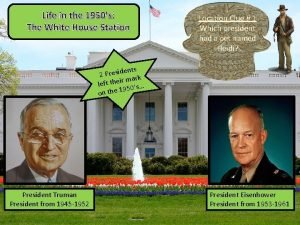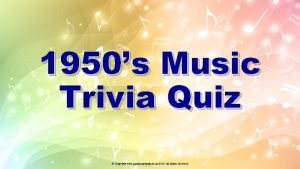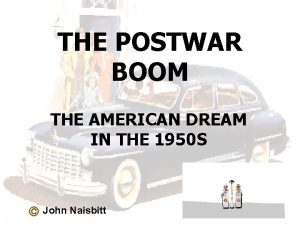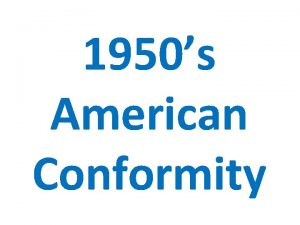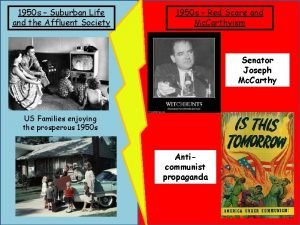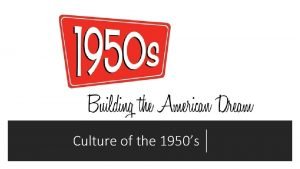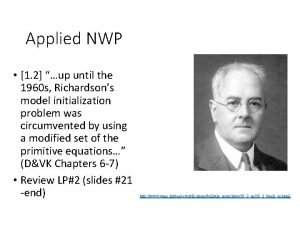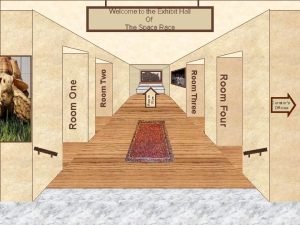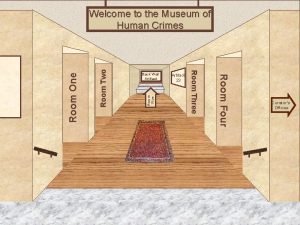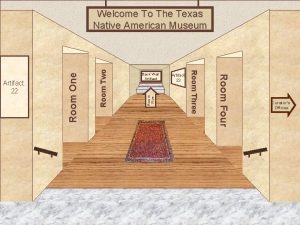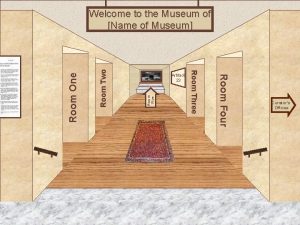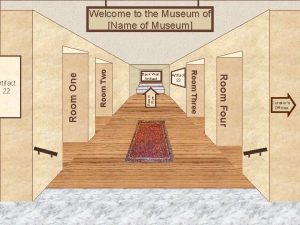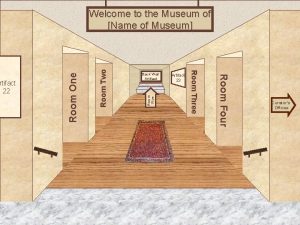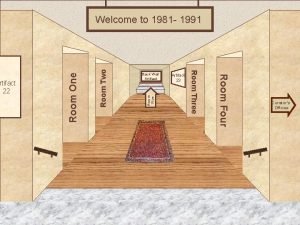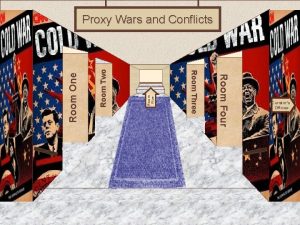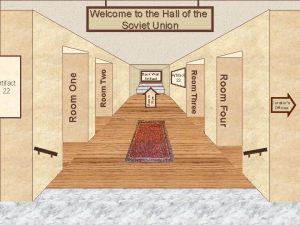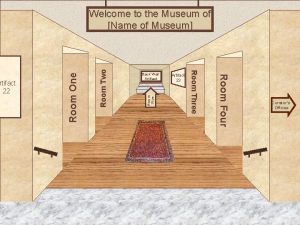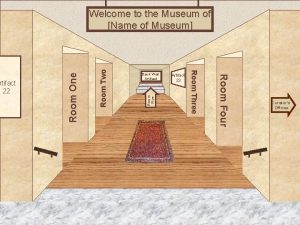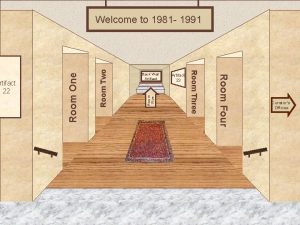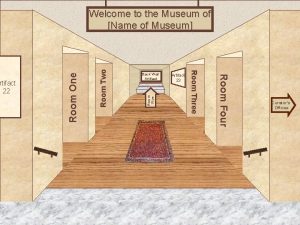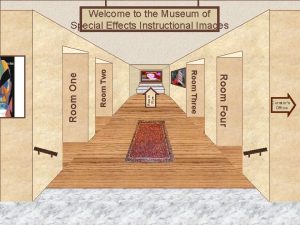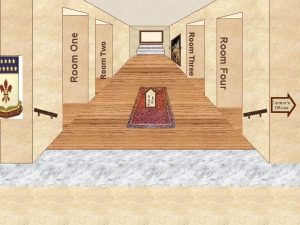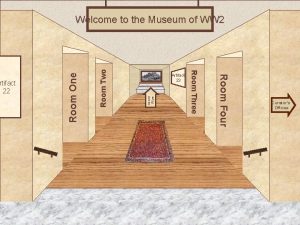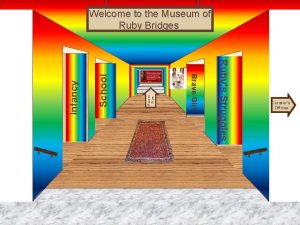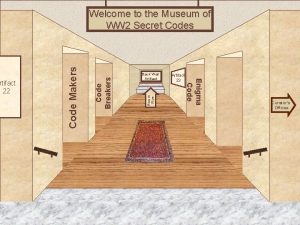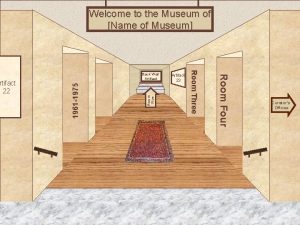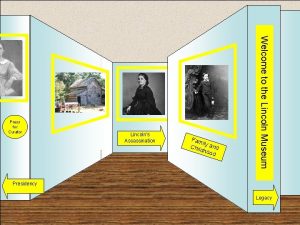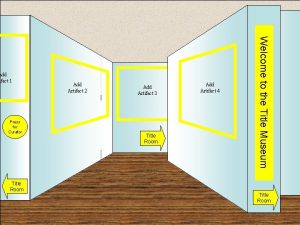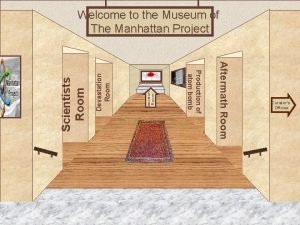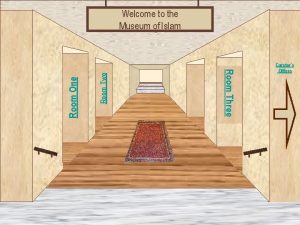1950s 1960s Artifact 23 Room Five Museum Entrance





![[Room 4] Room 4 Artifact 13 Artifact 14 Artifact 15 Return to Entry Artifact [Room 4] Room 4 Artifact 13 Artifact 14 Artifact 15 Return to Entry Artifact](https://slidetodoc.com/presentation_image_h2/5d61d734fb987f3cc35f2d7baf77914b/image-6.jpg)
![[Room 5] Room 5 Artifact 18 Artifact 17 Artifact 19 Artifact 21 Return to [Room 5] Room 5 Artifact 18 Artifact 17 Artifact 19 Artifact 21 Return to](https://slidetodoc.com/presentation_image_h2/5d61d734fb987f3cc35f2d7baf77914b/image-7.jpg)
























- Slides: 31

1950’s 1960’s Artifact 23 Room Five Museum Entrance 1980’s- 1990’s Back Wall Artifact 1970’s -1980’s Artifact 22 1940’s – 1950’s Technological Advances in the Cold War Curator’s Offices

Curator’s Office Name Curator’s Describe yourself here. Place your picture here. Contact me at [Your linked email address] Return to Entry Note: Virtual museums were first introduced by educators at Keith Valley Middle School in Horsham, Pennsylvania. This template was designed by Dr. Christy Keeler. View the Educational Virtual Museums website for more information on this instructional technique.

Nuclear Advancements Room 1 Artifact 2 Artifact 3 Return to Entry Artifact 4

Arms Race Room 2 Artifact 5 Artifact 6 Artifact 7 Return to Entry Artifact 8

US v. Russia Advancement Room 3 Artifact 9 Artifact 10 Artifact 11 Return to Entry Artifact 12
![Room 4 Room 4 Artifact 13 Artifact 14 Artifact 15 Return to Entry Artifact [Room 4] Room 4 Artifact 13 Artifact 14 Artifact 15 Return to Entry Artifact](https://slidetodoc.com/presentation_image_h2/5d61d734fb987f3cc35f2d7baf77914b/image-6.jpg)
[Room 4] Room 4 Artifact 13 Artifact 14 Artifact 15 Return to Entry Artifact 16
![Room 5 Room 5 Artifact 18 Artifact 17 Artifact 19 Artifact 21 Return to [Room 5] Room 5 Artifact 18 Artifact 17 Artifact 19 Artifact 21 Return to](https://slidetodoc.com/presentation_image_h2/5d61d734fb987f3cc35f2d7baf77914b/image-7.jpg)
[Room 5] Room 5 Artifact 18 Artifact 17 Artifact 19 Artifact 21 Return to Entry Artifact 20

Atomic Bomb The U. S had soon created the first atomic bomb on July, 1945. This intimidated the U. S. S. R and initially started off the Arms Race between the two. The crew who created the bomb were named the Enola Gay, and the bomb mostly consisted of radio active energy. Many test sites were available for the testing of the bomb and this soon led to the development of greater bombs; such as, the Hydrogen bomb. Linked citation goes here Return to Exhibit

Alamogordo The first atomic bomb was tested in Alamogordo, New Mexico. The test was first conducted in the final month of WW 2 by the top secret Manhattan Engineer District. The test was soon given the name “Trinity” and was tested in the desert. With 3, 200 square miles of open land sparse population, this area was the most ideal to test the bomb. Linked citation goes here Return to Exhibit

Enola Gay Only 1500 miles away on the island of Tinian, the Enola Gay crew was ready for take off. Heading towards Hiroshima, Japan; the crew dropped the first atomic bomb which had exploded with a force of 12. 5 kilotons of TNT. Only 3 days later the crew dropped another bomb on Nagasaki which soon led to Japans surrender in WW 2. Linked citation goes here Return to Exhibit

Kazakhstan Test Site In response to the challenge from the Americans, the Soviet Union fought back by testing their first bomb at Kazakhstan. Although not causing as much damage as the initial atomic bomb, the Soviet Union was now seen as a serious threat that soon began the Nuclear Warfare scare among both nations. Linked citation goes here Return to Exhibit

Hydrogen Bomb With the return of the challenge from the Soviets, the U. S began to start working on an even larger bomb in 1952. This bomb greatly outmatched the atomic bomb by being 1000 x stronger than the initial bomb. The first test was conducted on the Eniwetok atoll in the pacific. Once again the United States had advanced beyond their competitors and sparked even more funding towards Nuclear advancements during the Cold War. The main difference between both bombs was thermonuclear energy that drew atoms together instead of apart like the atomic bomb. Linked citation goes here Return to Exhibit

Ballistic Missiles After the “Massive Revelation” speech from Dulles, the United States had once again relied on the policy of brinkmanship, or all out war, against the Soviet Union. In 1954 the US started developing Ballistic Missiles against the Soviets. The missile was greatly improved with thermonuclear energy, inertial guidance systems, and powerful engines for multistage rockets. The best feature was the accuracy improvement. This missile could strike targets 8000 km away with high percentages that reigned supreme over other missiles at the time. Linked citation goes here Return to Exhibit

Sputnik October 4, 1957, the Soviets created the most impressive machinery at the time. The International Council of Scientific unions was established in July 1; who, created the first satellite ever. It weighed a total of 183. 9 pounds and could orbit the earth completely at 98 minutes. Many Americans had the growing fear of soviets using space as another destructive way of war or bombs. Due to the scare the US started funding more on science and rockets, which has started the space race. Linked citation goes here Return to Exhibit

Explorer 1 Determined to take back the lead in the Arms Race, the United States funded Dr. Wernher von Braun to construct the satellite. The next year it was launched January 31, 1958. Weighing a total of 30. 8 pounds Explorer 1 could orbit the earth 12. 54 times a day. But Dr. Braun had also inserted a cosmic ray detector designed to measure the radiation level in space. Van Allen calculated these belts of moving particles which were soon called the Van Allen Belts. The US had discovered that space had a completely different environment than earth due to the new development by the cosmic ray. Linked citation goes here Return to Exhibit

F-14 Tomcat The newest advancement in flighter planes (at the time) were the greatest airforce in the sky. Created in December 21, 1970, Grumman and Mc. Donnell Douglas completed the blue prints for the Tomcat. With M 61 Vulcan 20 mm Gatling gun in place, the planes firepower and accuracy was greatly improved and could now be fired up to long distances. The Tomcats solved the problem of incoming strikes against American carrier groups and were capable of putting a stop to most. The Arms Race was again hedged by the US and their latest technological advancement against the Soviets. Linked citation goes here Return to Exhibit

Grumman Factories Grumman co-partnered with the General Dynamics team in order to construct the Tomcat. Since they cost a lot of money, only 79 Tomcats were issued out but were far more superior than the Libyan jets. During the Iraq and Iranian war, the US and the Soviets were funding different countries for political reasons(proxy war). Tomcats were the greatest war advancements and helped the Shah come to power against the muslims. Even though Iran came back to the muslim power, the US had dominated the airial warfare and pushed the Soviets out or power. Return to Exhibit

AT-4 (Spigot) The Spigot was designed to replace the slower and out dated model AT-3 SAGGER. By becoming smaller and more agile, it guided missles to a 90% average to their target. The SPIGOT had semi automatic command-to-lineof-site antitank guided missiles with a heat warhead. The missiles could reach up to 185 meters per second with maximum flight time of up to 11 seconds. With this new equipment the soviets took charge of ground wars by creating a powerful system of engaging more targets at longer distances. Linked citation goes here Return to Exhibit

Kresta Since the US dominated the airforce, the Soviets built their naval fleet to the worlds greatest during the time. In 1974, Kresta became the biggest predator out on the sea with all the improvements. It weighed 6000 tons and could travel 30 knots. Turbojet missiles packed with Shaddock could now reach up to a 400 mile range. They tried establishing a base at the US shorelines and Cuba but were soon shot down by the airforce. In the end the Soviet navy had outnumbered the US naval fleet 25 to 1, but the US was still becoming even more advanced than Russia. Linked citation goes here Return to Exhibit

Text goes here. Linked citation goes here Return to Exhibit

Artifact 14 Text goes here. Linked citation goes here Return to Exhibit

The Internet The most complex system connecting all computers and devices together for communicational purposes was put out for the world in 1984. When Paul Mockapetris introduced the dominion name, the Massachusetts computer company came right after in 1985. Only from there on did the US ever invent something so great that affected our world today, since we still use the internet now. Linked citation goes here Return to Exhibit

Stanford Research Institute Starting out as a project at Stanford the initiative of creating the Internet. Many great and intelligent minds were used and here are some of the most important. The NWG had its first meeting chaired by Elmer Shapiro, who discussed and voiced the idea of the internet and its uses for the good of the economy. Soon the first network equipment came out which was called the switch. It moved data from the host to the switch. Then the first message and email were sent thanks to Ray Tomlinson and Charley S. Kline. After that, improvements only made the internet faster and less easy to crash. We still use it today as our main source of getting information. Return to Exhibit

Artifact 17 Text goes here. Linked citation goes here Return to Exhibit

Artifact 18 Text goes here. Linked citation goes here Return to Exhibit

Artifact 19 Text goes here. Linked citation goes here Return to Exhibit

Artifact 20 Text goes here. Linked citation goes here Return to Exhibit

Artifact 21 Text goes here. Linked citation goes here Return to Exhibit

Artifact 22 Text goes here. Linked citation goes here Return to Entrance

Artifact 23 Text goes here. Linked citation goes here Return to Entrance

Back Wall Artifact Text goes here. Linked citation goes here Return to Exhibit
 Baripity
Baripity To room 19 book
To room 19 book Hotel database sql queries
Hotel database sql queries Bedroom kitchen bathroom
Bedroom kitchen bathroom What groups were experiencing poverty in the 1950’s?
What groups were experiencing poverty in the 1950’s? 1950's music trivia questions and answers
1950's music trivia questions and answers Color tv started
Color tv started Conglomerates and franchises 1950s
Conglomerates and franchises 1950s Beaniks
Beaniks Trends of 1950s
Trends of 1950s Beat writers 1950s
Beat writers 1950s Challenges to conformity in the 1950s
Challenges to conformity in the 1950s Trends of 1950s
Trends of 1950s Daily life and popular culture in the 1950s
Daily life and popular culture in the 1950s Catcher in the rye 1950s culture
Catcher in the rye 1950s culture 1950s future cars
1950s future cars Trends of 1950s
Trends of 1950s 1950s beatnik fashion
1950s beatnik fashion Suburban life 1950s
Suburban life 1950s Trends of 1950s
Trends of 1950s Why does richards rush to tell mrs. mallard the news
Why does richards rush to tell mrs. mallard the news Mass media 1950s
Mass media 1950s Red scare 1950s
Red scare 1950s The affluent society 1950s
The affluent society 1950s School punishments in the 1950s
School punishments in the 1950s 1950s conformity and counterculture
1950s conformity and counterculture Leonid gavrilov
Leonid gavrilov Early computers 1980s
Early computers 1980s Up until the 1960s
Up until the 1960s S.e hinton in the 1960s
S.e hinton in the 1960s Example of software crisis
Example of software crisis The outsiders background information
The outsiders background information




